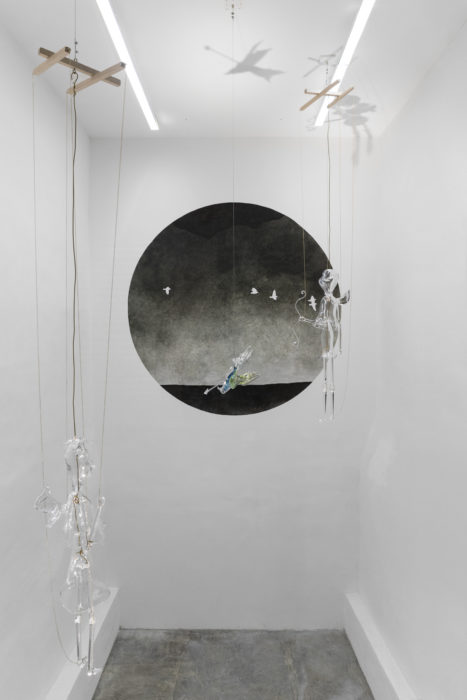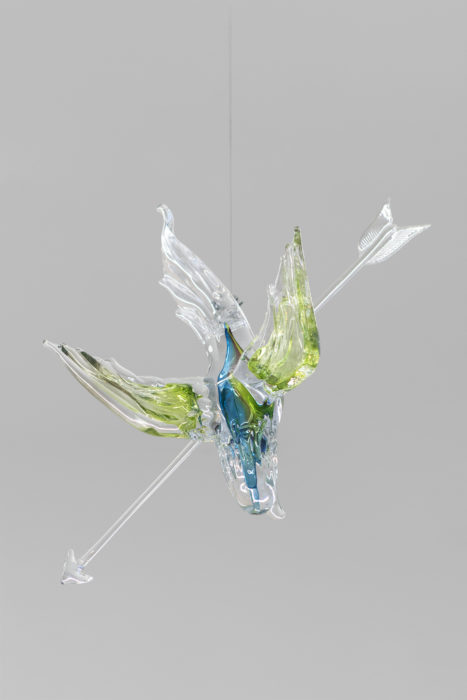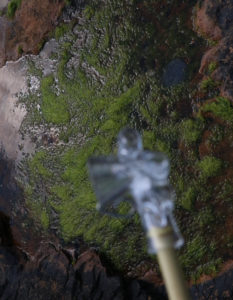“I wanted to work with glass, for its transparency, fragility,” says Hayley Silverman via an email chat when I ask her about process and her choice of material, “you are surrounded by blazing red furnaces and lit torches and melting substances that constantly need heat to be sculpted.”

The New York-based artist goes on to akin the substance of glass with soup, where it is “similarly cooked, torched and scoured before its form is teased out,” and references a line Ruby Tandoh wrote for her forthcoming book Is it soup yet? where she quotes, “consider the flame that the pot is set over…heat is a violent disruption, serving to break down the integrity of the building blocks of the soup. So carrots and onion soften and meld, and become carrot-onion-broth. This joining is violent, and so soup, by its very essence, is brute, destructive physicality.”
Silverman, who works across disciplines like sculpture, theatre and photography, as well as interspecies collaborations with dogs, just opened solo exhibition The Living Watch Over the Living at Florence’s VEDA gallery on September 29 and it will be running to December 1. The installation is a ‘mythic tableau in glass’ where two five-foot angelic marionettes hang/float around a suspended bird who has been shot in mid flight. The sculptural scene sits in front of a landscape painting on the wall behind. A continuation of her research into the relationship between the technological and spiritual, the press release describes the show as drawing “parallels between heavenly observation and pervasive sensing, otherwise known as big data.”
** You seem to wander through material in the same way you wander through memory, history and time, what is the fabric of your process?
Hayley Silverman: I learned a love of materiality from my mother. She was a textile designer and faux finish painter who rendered vivid sky murals, gold leafed synagogues, and marbled casino entryways. I recently learned she painted Queen Latifah’s mother’s house and also contributed to the short-lived Fashion Cafe in Rockefeller Center. Her process made me understand and feel the power materiality has in creating an affect of holiness, wealth, and desirability (as art has historically always done.)
**Does your work reference specific stories or do you aim to be create a more abstract scenario that can’t really be placed

HS: In speaking with Damon Zuconni for the show’s booklet, I wrote about a crossroads that both angels and Big Data play in the surveillance of people. Researching angel’s in the Abrahamic religions made me think a lot regarding the ‘messenger’… the messenger as a guise for cis-heteronormative, white able-bodied beauty.
“Not all flesh is alike, but there is one flesh for human beings, another for animals, another for birds, and another for fish. There are both heavenly bodies and earthly bodies, but the glory of the heavenly is one thing, and that of the earthly is another (1 Corinthians 15:39-40).”
It led to a wormhole of ideas concerning the puppetry of religion and social control, law-abiding roleplay and roleplay of power at large. Angels are sent as messengers to watch and record your life for judgement, while algorithms never sleep, logging and storing your searches for the future too. Nineteen-ninety-two’s Minority Report, which is set in 2045, creates a dialogue about the ideological dilemmas of free will versus determinism via Tom Cruise. Both religion and the government/controlled/data/collecting internet perform a massive amount of non-consensual snooping that ends up somewhere in a heavenly or digital ‘book.’
** In terms of your past projects, can you talk about what ‘the dog’ means to you?
HS: The dog means a lot to a lot of people, but also to history and to evolution and to cartoons and marketing and companionship. I have always felt it was important to make art interspecies. Neoclassical sculptures at the Louvre and everywhere else always have children with geese or Greek gods conquering monstrous chimeras. Animals have always been important to storytelling. My plays are of hybrid purpose, where animals have their agency (they are unleashed and undirected) and yet they carry a speaker that plays a pre-recording of a human voice. They physically carry, like domesticated animals do — people’s things around, but this time the stories I use are ones I feel can be re-inhabited differently.

They range from Richard Linklater films, to science-fiction thrillers, to Depression-era musicals that rhapsodize class difference. The performances investigate how our understanding of narrative, authority and identity transforms when we project stories, dialogues and emotions onto animals. The plays in this sense fall into a tradition of mythologies and fables in which animals are carriers of hidden messages, promises, and magical functions. They straddle the division between the human body and the non-human body, as well as bring out the interplay between control and chaos.**














